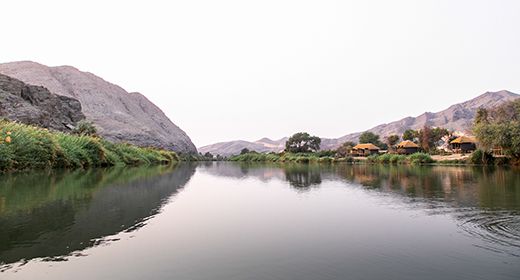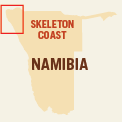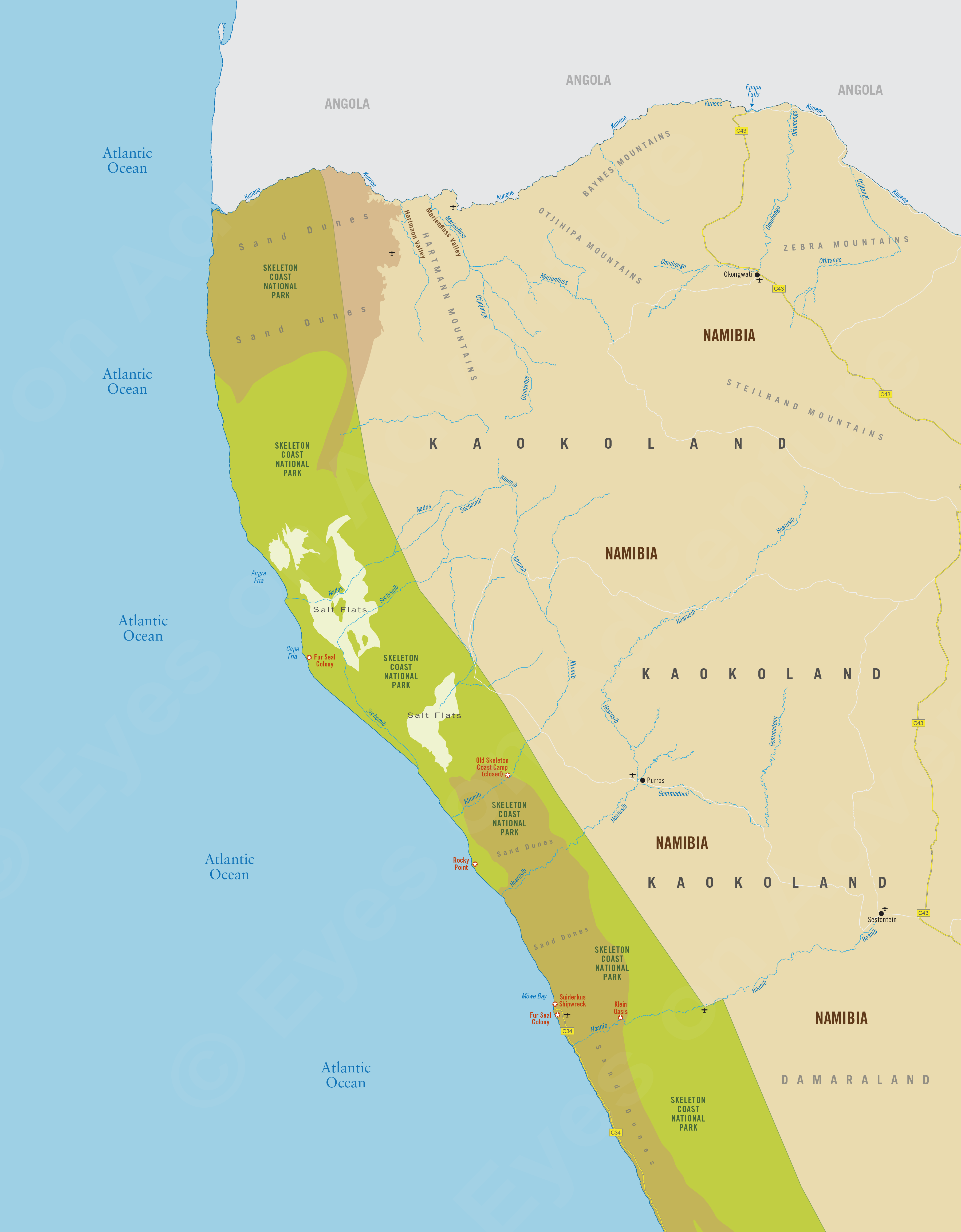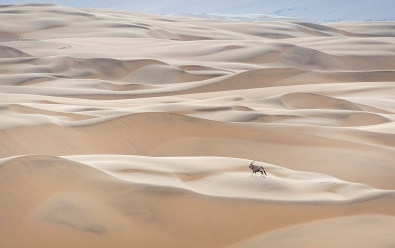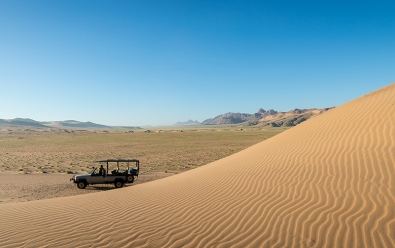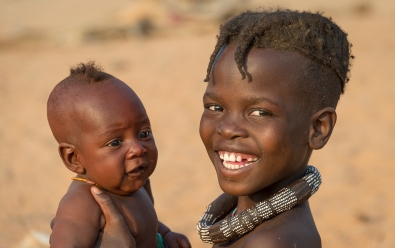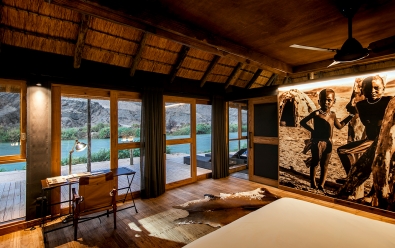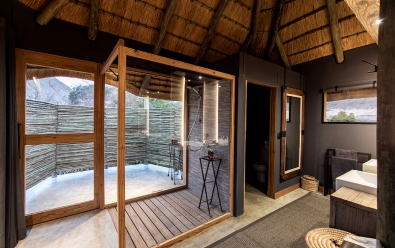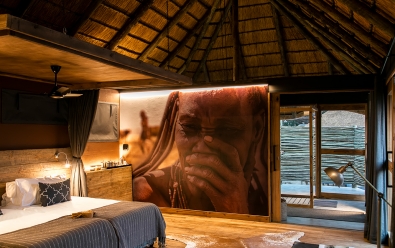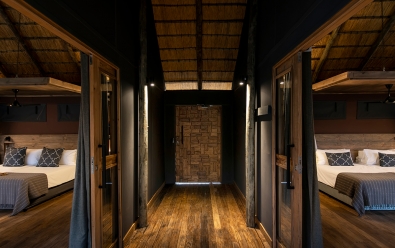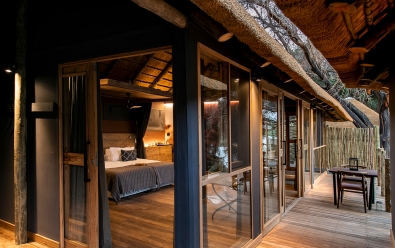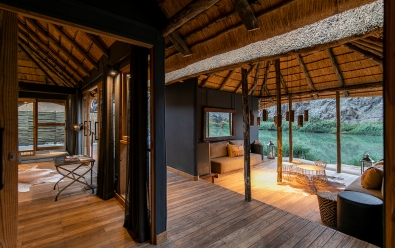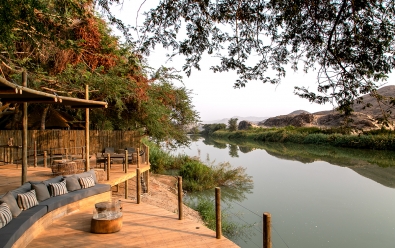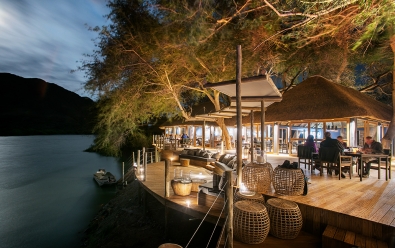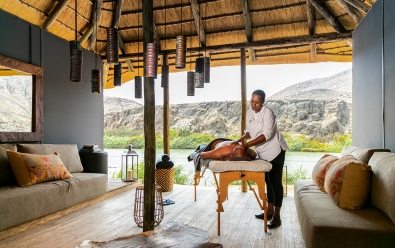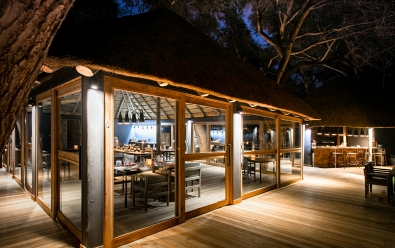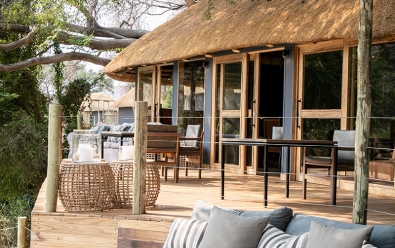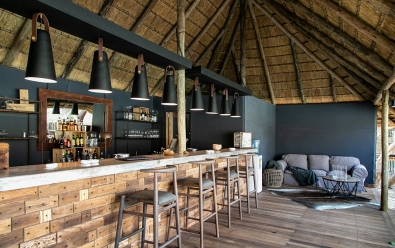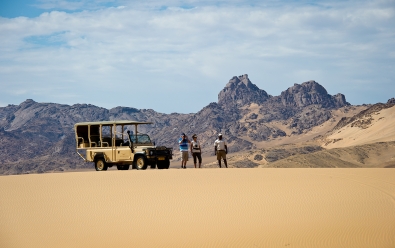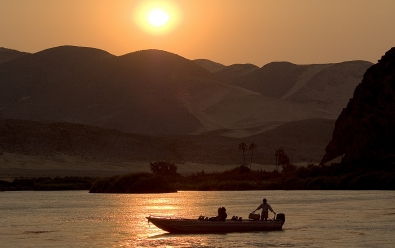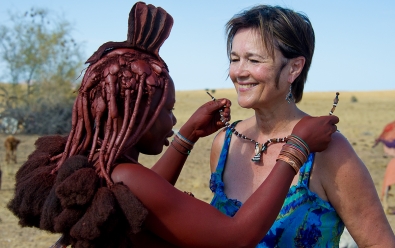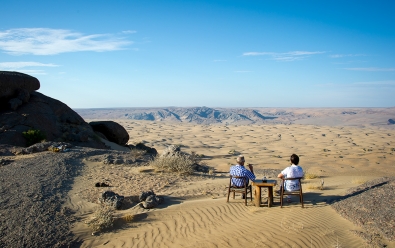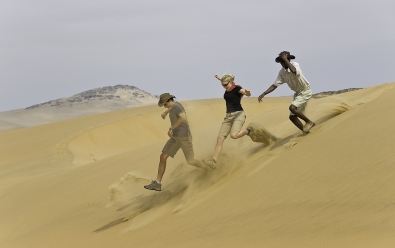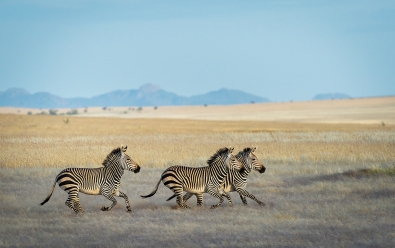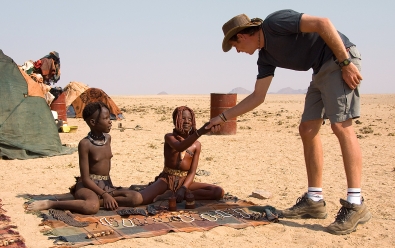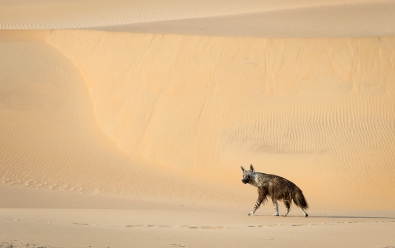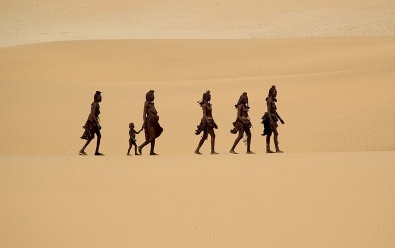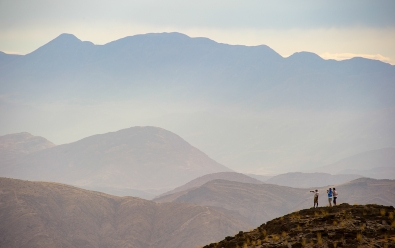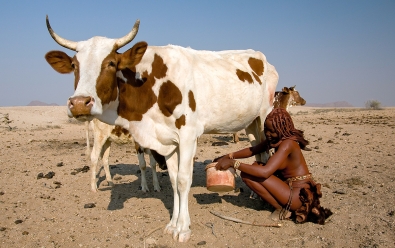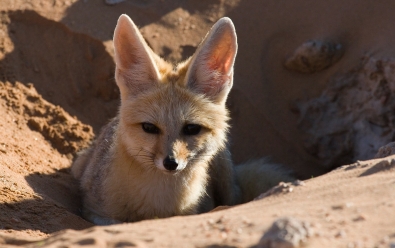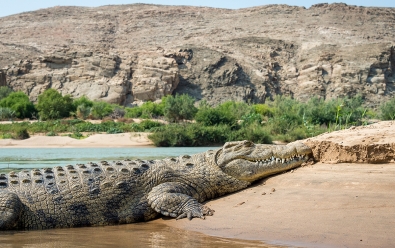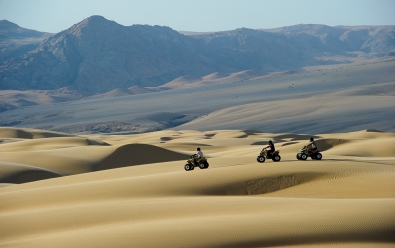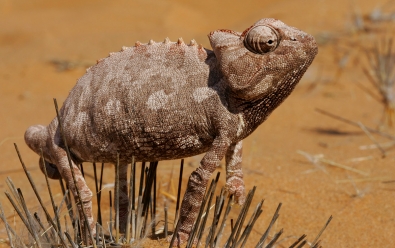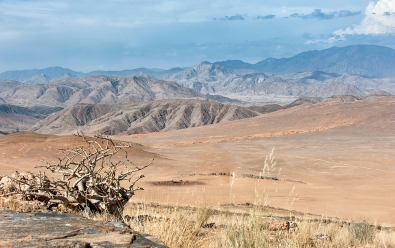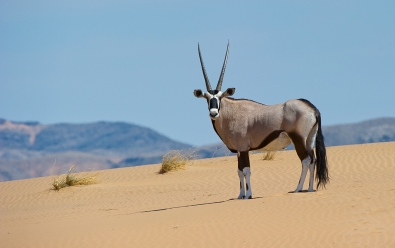Serra Cafema Camp
Highlights
- One of the most untouched and remote destinations in Africa
- Diverse setting major river, sand dunes, and desert mountains
- Interact with and learn about the lasting culture of the Himba people
- Nature drives, boating, quad biking, walking, and cultural experiences
Location
- Kunene River
- Kunene Region
- Far Northwest Namibia
Serra Cafema Camp is located along the Kunene River in one of the most remote and untouched areas in Southern Africa, where a river flows through a dune-covered desert.
The camp is situated on the southern bank of the Kunene River within the Marienfluss Conservancy, which is owned by the local Kunene people, most of whom belong to the indigenous, semi-nomadic Himba tribe. The conservancy covers 1 160 square miles (3 000 sq kms) and is part of a far larger area that is Namibia's least populated region and includes the Skeleton Coast and Kaokoland.
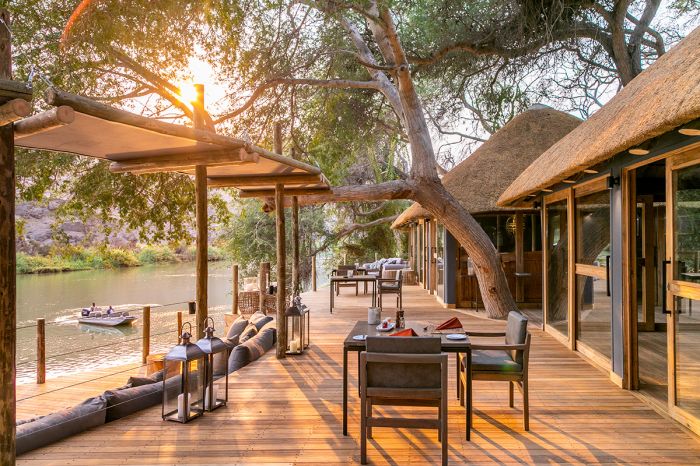
Main area deck and view of the river.
The Kunene region is spectacularly diverse, with the Kunene River flowing westward through various landscapes that includes towering sand dunes before reaching the Atlantic Ocean not far west of the camp. The riverbanks are lined with lush vegetation, which provides a lovely contrast in this otherwise dry desert biome. Southeast of the camp is Hartmann Valley, which bounded on the west by the sand dunes and on the east by the rugged Hartmann Mountains. The valley comes to life after rare rainfall, attracting wildlife that come to graze on the new vegetation.
Guests to Serra Cafema will explore the diverse landscapes on open 4x4 vehicles, quad bikes, boat, and on foot. Wildlife that can be seen includes springbok, Hartmann's mountain zebra, oryx, bat-eared fox, brown hyena, and ostrich. Crocodiles are often seen in the river. Birdlife is particularly good along the river and in Hartmann Valley.
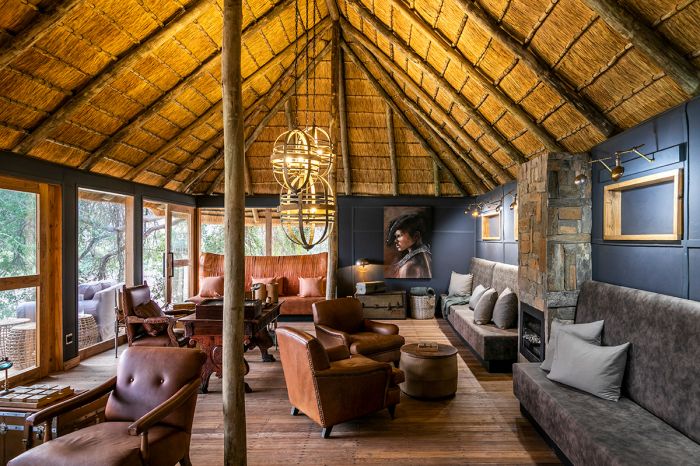
Main area lounge.
Serra Cafema Camp offers 8 spacious tented guest units with décor reflective of the local Himba culture. One of the tents is a double unit that is ideal for a family or a couple wanting extra space and luxury. The tented rooms are constructed atop raised wooden platforms and connected to the camp's main area by elevated wooden walkways. Each guest unit has a private outdoor deck with seating and giving views onto the Kunene River below.
The camp's main area includes various dining and lounge areas atop an elevated wooden deck under thatching, with excellent views over the river. There is also a pool deck with loungers. In-room massage treatments are on offer for those looking for some pampering
Wilderness Safaris are one of Africa's leading safari operators and they strive to minimize energy consumption at all their camps. Serra Cafema Camp is 100% powered by a large bank of solar panels with a generator used as a backup. Water is supplied from boreholes and is safe for consumption; however, purified drinking water is provided. Strict eco-friendly environmental standards are maintained so that no harmful chemicals or waste is allowed to enter the ecosystem of this untouched wilderness.
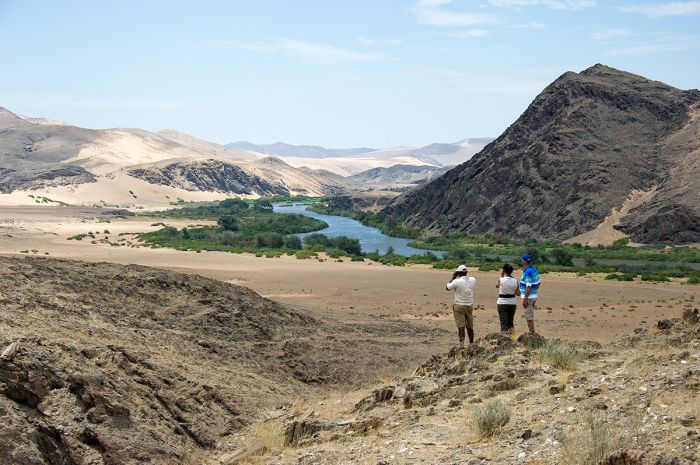
Lovely vista of the Kunene River near Serra Cafema Camp.
About the Kunene
The Kunene River rises in the highlands of Angola, flowing south for hundreds of miles before turning west, where it becomes the boundary between Namibia and Angola and eventually draining into the Atlantic Ocean. The course of the river covers around 650 miles (1 050 kms).
There are two spectacular valleys in the Kunene region of Namibia: Hartmann Valley and Marienfluss Valley. After any seasonal rains (which are infrequent), these valleys erupt with fresh grasses, which attracts springbok, Hartmann's mountain zebra, and oryx. Other wildlife includes brown hyena, bat-eared fox, and ostrich. Marienfluss is the richer of the two valleys, especially after a rare rainfall.
To the west of Hartmann Valley are towering dunes that mark the start of the Skeleton Coast region. Interesting 'fairy circles' are found in Marienfluss Valley and, to a lesser extent, in Hartmann Valley.
The Kunene River is home to good numbers of Nile crocodile and Nile monitor lizard, as well as numerous fish and bird life.
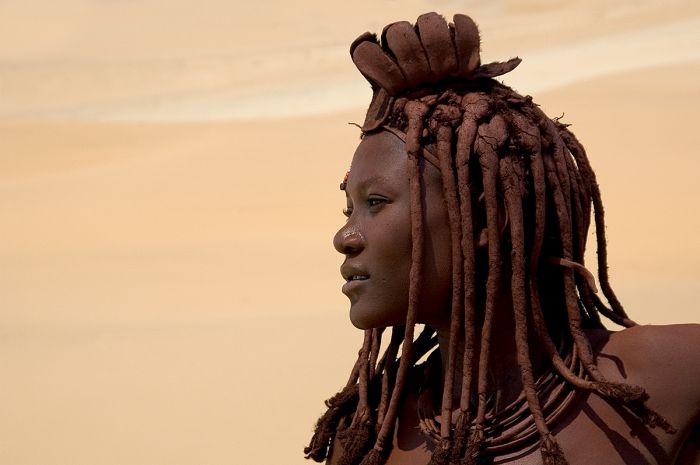
A local Himba woman at Serra Cafema Camp.
About the Skeleton Coast & Kaokoland
Namibia's Skeleton Coast refers to the northern one-third of the country's lengthy Atlantic Ocean coastline. The region extends from the Ugab River in the south to the country's northern border with Angola at the Kunene River, a distance of 315 miles (510 kms).
The Portuguese were the first Europeans to explore this coast during the 1600s and they dubbed it the "Coast of Death", in testament to its dangerous offshore waters, which were often covered in thick fog, causing many a ship to run aground. Thousands of sailors lost their lives in hundreds of shipwrecks and those that survived were usually doomed to starvation and exposure on the unforgiving beaches or further inland.
The entire coastline and a narrow strip inland is protected as the Skeleton Coast National Park (established in 1971), which covers 6 504 square miles (16 845 sq kms). Self-drivers are not permitted into the park, which is strictly regulated and controlled by the park authorities, so fly-in safaris are the only option. For this reason and owing to the remoteness of the region, few travelers are fortunate enough to visit this incredible destination; however, we cannot recommend it highly enough.
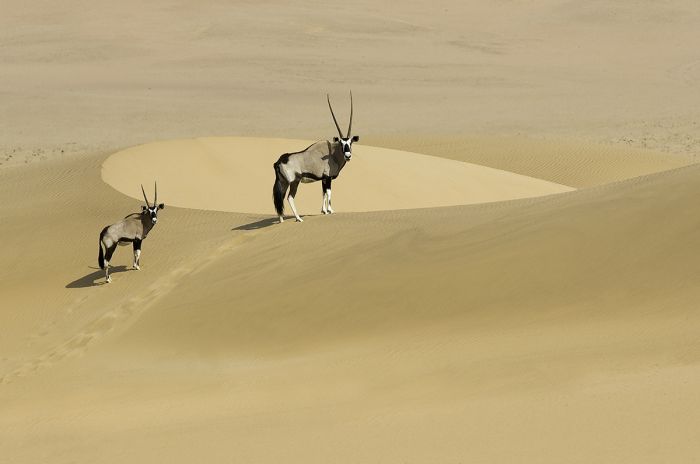
Oryx on the sand dunes near Serra Cafema Camp.
The Skeleton Coast / Kaokoland is one of the most pristine wilderness areas that is available to tourists in all of Africa. The landscapes can surely be described as 'other-worldly', with towering golden dunes that form crescent-shaped ridges of sand, ethereal rivers that only flow after rare rains, bitterly cold ocean waters that create thick fog most mornings when the sea air meets the hot sand inland, and barren hills, rocky outcrops, and rugged mountains inland.
Besides the jaw-dropping landscapes, visitors will be amazed by the fact that wildlife does exist in this extreme region. The lack of permanent fresh water means that the numbers and variety of animals here is low and is restricted to species that are adapted to the desert. In terms of wildlife seen in the Skeleton Coast, perhaps most surprising are the desert-adapted elephants and lions that manage to survive here.
The elephants in the Skeleton Coast have learned where to dig in the river beds and the lions can literally go months without drinking water, surviving by licking up morning dew from vegetation or 'elephant wells'. Other species commonly seen here include giraffe, springbok, oryx, brown hyena, and black-backed jackal.
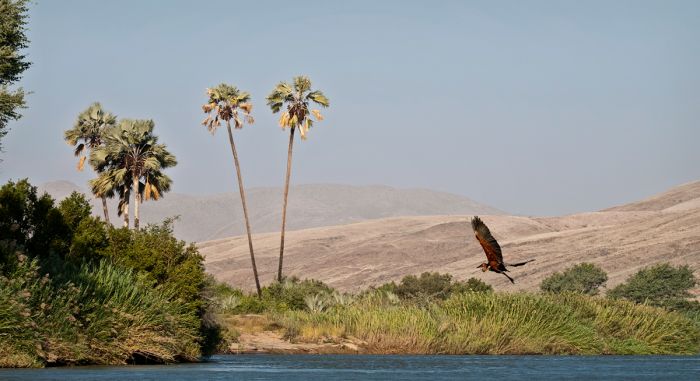
A goliath heron takes wing above the Kunene River.
Inland from the sand dunes, Kaokoland is also home to black rhinos, which are perfectly adapted to the land, even consuming plants that are poisonous to humans and other animals. There are also two popular Cape fur seal colonies that can be visited, one at Möwe Bay and the other further north at Cape Fria.
The region directly east of the northern half of the Skeleton Coast is informally called Kaokoland, while the area east of the southern half of the Skeleton Coast is called Damaraland. Kaokoland is Namibia's most sparsely populated region due to the very dry and harsh landscape, which is dominated by gravel-strewn plains, rugged mountains, precious little water, and sparse vegetation.
Visitors may be fortunate to encounter members of the indigenous Himba people that live throughout Kaokoland. The Himba are semi-nomadic pastoralists that live in transient communities with their cattle and goats. They are distinctive in appearance, covering their entire bodies and hair with an ochre-colored paste to provide them protection from the harsh sun. Due to the low number of tourists to the area, The Himba have managed to maintain their traditional way of living.
ROOMS INCLUDES & EXCLUDES CHILDREN FACILITIES ACTIVITIES
Accommodation
8 guest accommodations in total comprising:
- 7 twin-bedded canvas tented units, each with two three-quarter beds. Mattress converters are available that transform the twin beds into a king-size bed. To be arranged prior to arrival.
- 1 family unit consisting of two bedrooms, each with two three-quarter beds and each with its own en-suite facilities. Both bathrooms have an indoor shower, outdoor shower, double-basin vanity, and separate toilet. There is a shared outdoor shaded deck with a table and seating, plus a sunken outdoor lounge with seating.
Each stylish canvas-tented accommodation pays homage to the Himba culture and is constructed atop raised decking under thatch roofing and offers views over the Kunene River. En-suite facilities include an indoor shower, outdoor shower, a double-basin vanity, and separate toilet. Each unit also has a private outdoor shaded viewing deck with comfortable seating.
The units are connected to the main camp area by elevated wooden walkways.
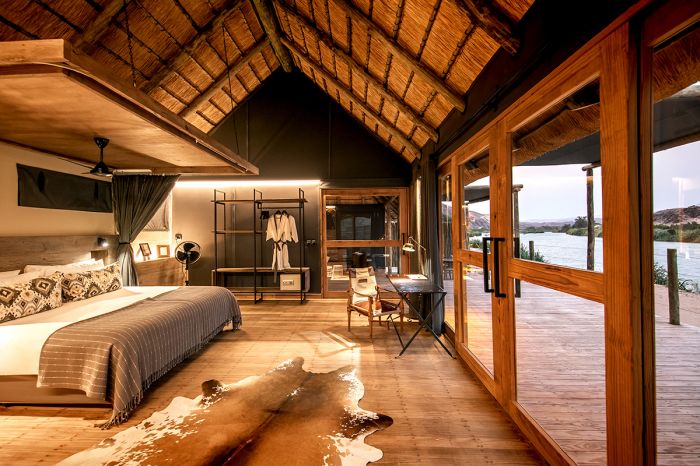
Guest tent interior at Serra Cafema Camp.
Guest room amenities include an indoor lounge area with comfortable easy chairs, a writing desk and chair, multi-plug charging facilities, a private outdoor viewing deck with loungers, and mosquito netting for the beds.
Other items and features in the guest units include:
- Luggage rack.
- Mini-bar.
- Electronic safe.
- Hair dryer.
- Tea and coffee making facilities.
- Pedestal fan and ceiling fan.
- In-tent Wi-Fi.
- Olympus equipment (includes a pair of binoculars).
- Personal amenities, including bathrobes, liquid soap, body wash, shampoo and conditioner, body lotion, room spray, insect repellent, tissue dispenser, shower caps, vanity kit with cotton-tip swabs, cotton balls, laundry bag, and garment washing powder (for underwear on request).
Serra Cafema Camp can accommodate a maximum of 18 guests in total: 2 adults and 2 children in the family unit and 2 persons in each of the other 7 standard guest units.
Includes & Excludes
Includes:
- All meals and local beverages including wines, spirits and liqueurs, but excluding premium imported brands and Champagne.
- Twice-daily scheduled camp activities (accompanied by experienced guides).
- Laundry services are provided on a daily basis (weather permitting, items will be returned on the same day). Laundry is dried by the sun and on most days any laundry placed out in the morning will be returned by the evening.
- Wi-Fi access.
- Tourism levy and VAT.
Excludes:
- Premium imported beverages and Champagne.
- Any applicable wildlife fee, park fee, reserve fee, concession fee, other land-use fee.
Single Supplement
A single supplement will apply for any room booked by a single traveler; please ask us for pricing.
Children
Children aged 6 years and older are accommodated at Serra Cafema:
- For families traveling with children between 6 and 12 years, private activities must be booked and paid for.
- Children between 6 and 16 years must share with an adult/s in the same room.
- The minimum age for walking activities is 13 years.
- The minimum age for quad-biking is 16 years.
Facilities
The camp design and interiors reflect the culture of the indigenous Himba people that live in this diverse region.
Main area facilities include:
- The main area is constructed upon an elevated wooden deck and comprises various dining and lounge areas, plus sunken viewing decks and a bar under thatch.
- Pool in main area.
- In-tent massage treatments (at extra cost).
- During winter months a gas heater is stationed in the main area and chenille blankets are provided during dinner.
- Guest toilets in main area.
Activities
Activities included in the rate:
- Nature drives (day and night) in Hartmann Valley using 5x 10-seater open Land Cruisers, each accommodating a maximum of 7 guests. In cooler weather conditions, hot water bottles and lined ponchos are provided on nature drives.
- Quad biking.
- Nature walks.
- Boating on the Kunene River (subject to water levels).
- Interacting with the Himba people.
- Stargazing.
- Camp chats about the area and its geology, the Children in the Wilderness program, and the Kunene people and their conservancy.
Optional activities at additional cost:
- Private activities are on offer (subject to vehicle availability which needs to be booked in advance).
Example of a typical day:
- Early morning wake-up call (wake-up and activity times vary according to the seasons, activities on offer, and wildlife sightings).
- Breakfast before departing on the morning activity.
- Return to camp for a meal and rest period. Note that distances covered can be long in this vast area, so longer days with a packed lunch are also offered for those wishing to get the full experience.
- Meet for afternoon tea and snacks (savory and sweet choices) before departing on the activity.
- Return to camp - freshen up or meet for drinks, followed by dinner.
- Enjoy a nightcap on the deck before retiring.
Great Good Fair Poor
- Jan
- Feb
- Mar
- Apr
- May
- Jun
- Jul
- Aug
- Sep
- Oct
- Nov
- Dec
When to Visit
The Skeleton Coast, Kaokoland and Kunene River are year-round destinations, with very little variation in temperature. Rain is virtually non-existent and annual rainfall rarely exceeds 10 millimeters (0.39 in).
The waters offshore are bitterly cold, brought north by the Benguela Current, and the resultant cold air over the water creates heavy fog on most mornings as it mixes with the warm air over the land. The fog usually dissipates by mid-morning, but it can linger longer on some days. Most days are sunny and warm.
Serra Cafema Camp is open year-round.
Winter
The winter months are May through October and the temperatures are moderate, with early mornings averaging a chilly 54-57°F (12-14°C), but warming to 70-73°F (21-23°C) later in the day. Rainfall is rare to nonexistent and almost every day is clear and sunny.
Summer
The summer months are November through April and this is the only time that rainfall occurs, although it is uncommon. Temperatures are slightly warmer, averaging 59-62°F (15-17°C) in the morning and usually accompanied by fog along the coast. Daytime temperatures are warmer, averaging 78-84°F (25-29°F). Days are almost always clear and sunny, with the occasional cloudy day.




